Belize
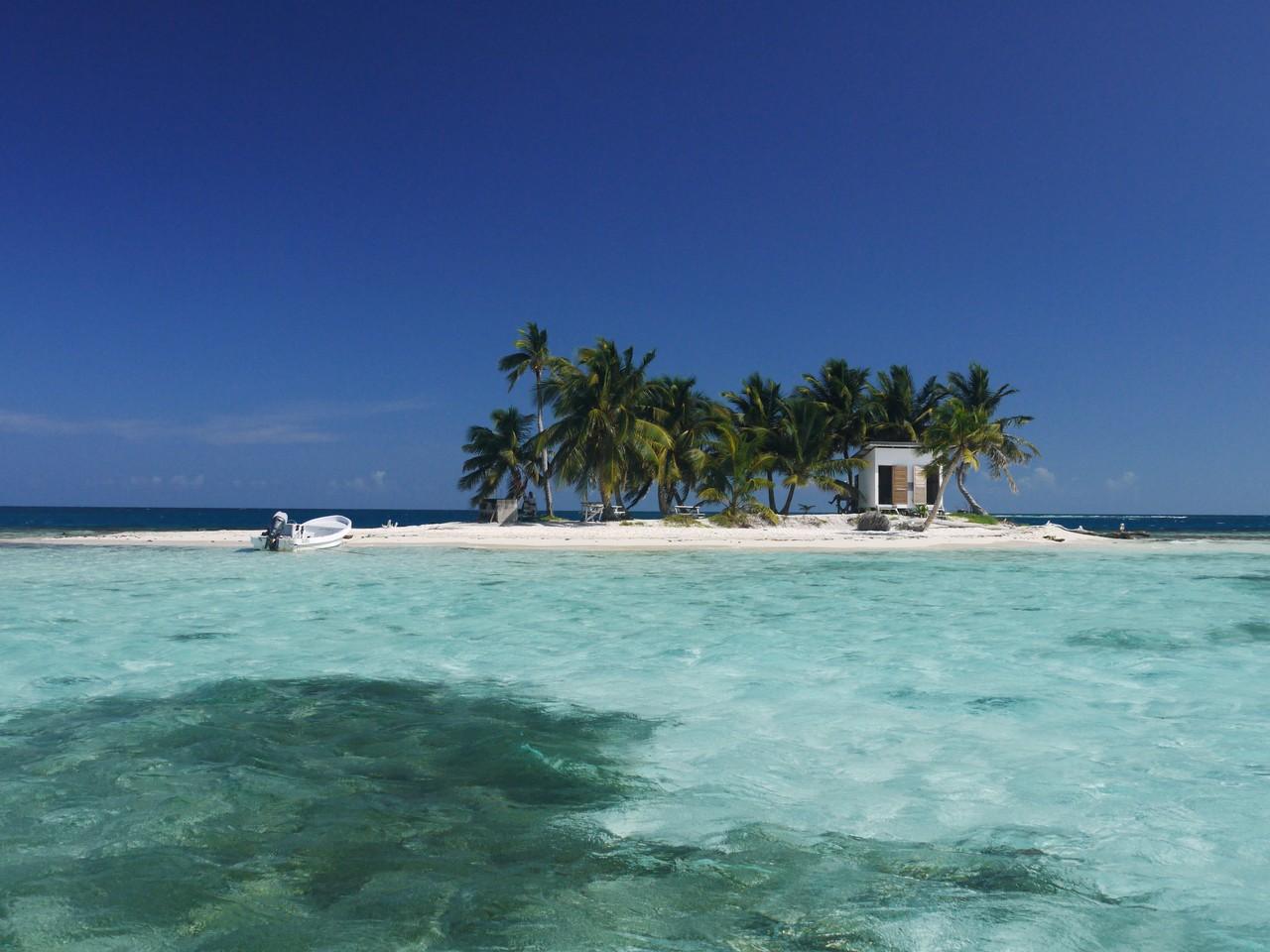 Silk Cayes
Silk Cayes
Background
Belize - we barely knew of its existence until recently, but we’re not the first to fail to notice that it’s there. When the Spanish were colonizing what is now Latin America they missed a few spots, and the British wasted no time moving in. Belize is one of those spots. It somehow managed to remain British through the centuries, and finally became independent in 1981. The tiny population of 280,000 is a mix of Caribbean Creoles who speak a lovely broken English dialect, Spanish-speaking mestizos, Maya, Garifuna, German-speaking Mennonite farmers from Canada, Chinese shop owners, descendents of white settlers, some expats, and everyone else who ever washed up on the shore here.
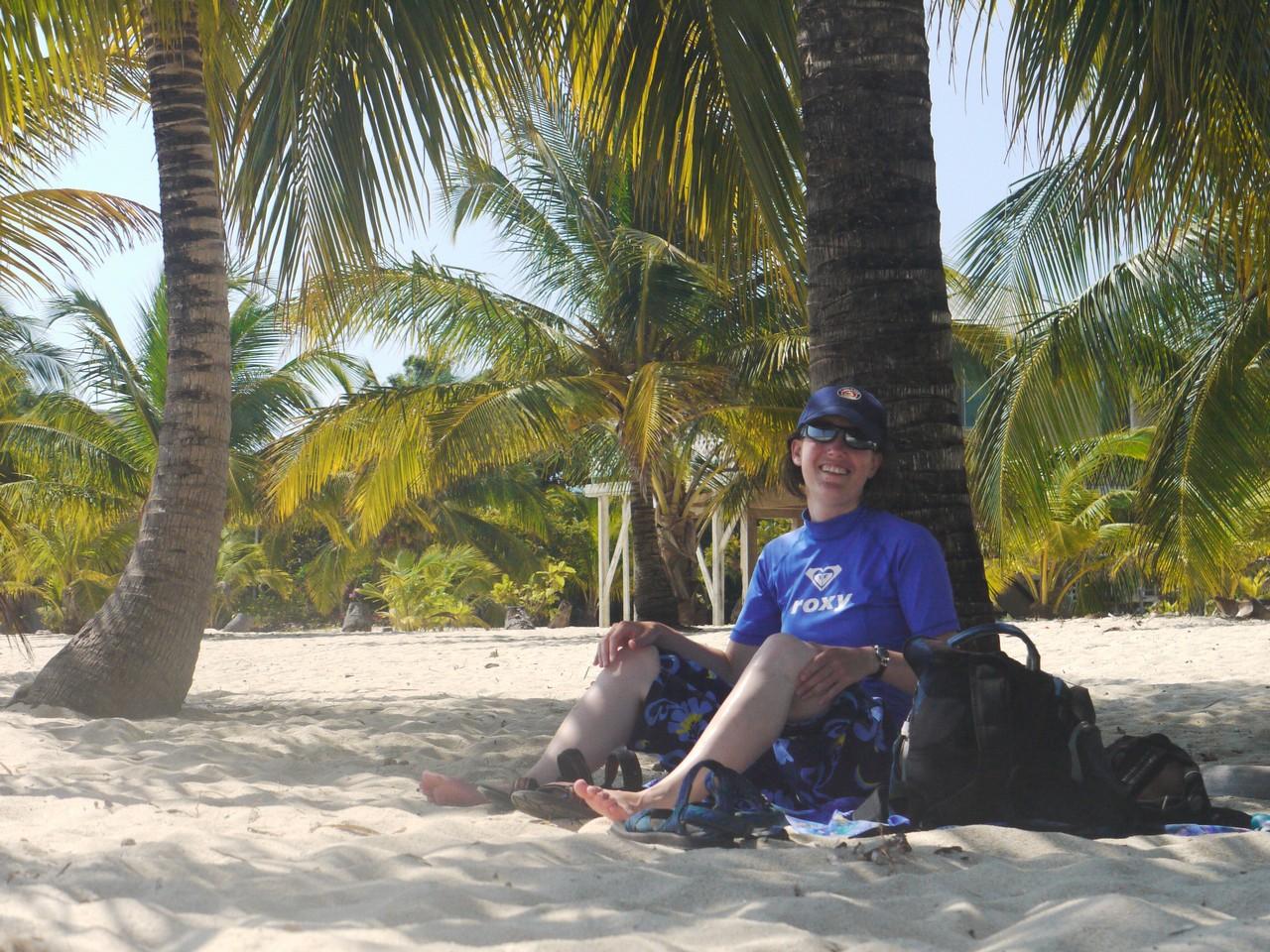 Beach time, Placencia
Beach time, Placencia
Politically stable and very beautiful, Belize might have been a tropical paradise. Unfortunately, every few years it is flattened by hurricanes and has to be rebuilt more or less from scratch. Local industry is almost nonexistent, corruption is common, and much of the country is rather poor. Costs for travellers are a bit higher than elsewhere in the region, which keeps many backpackers away. Big resorts haven’t taken over all the good spots yet, but there’s little regulation to stop them, so visit now before it becomes a patchwork of golf courses surrounded by high fences.
British influence certainly makes it unique in the region. Everyone speaks English, so chatting up the locals is much easier. In addition to tortillas and frijoles you can get meat pies and ginger beer. And best of all, most of the roads are paved!
Itinerary
Punta Gorda
What is it: dusty, semi-derelict beach town in the deep south, strangely reminiscent of Ein Hatchelet where Ron’s father grew up.
Things to do: free chocolate factory tour with tastings (see below).
Colourful characters: troops of Western volunteers hitting the town for some R&R after roughing it in the surrounding villages.
Watch out for: open storm drains. It’s very easy to fall in.
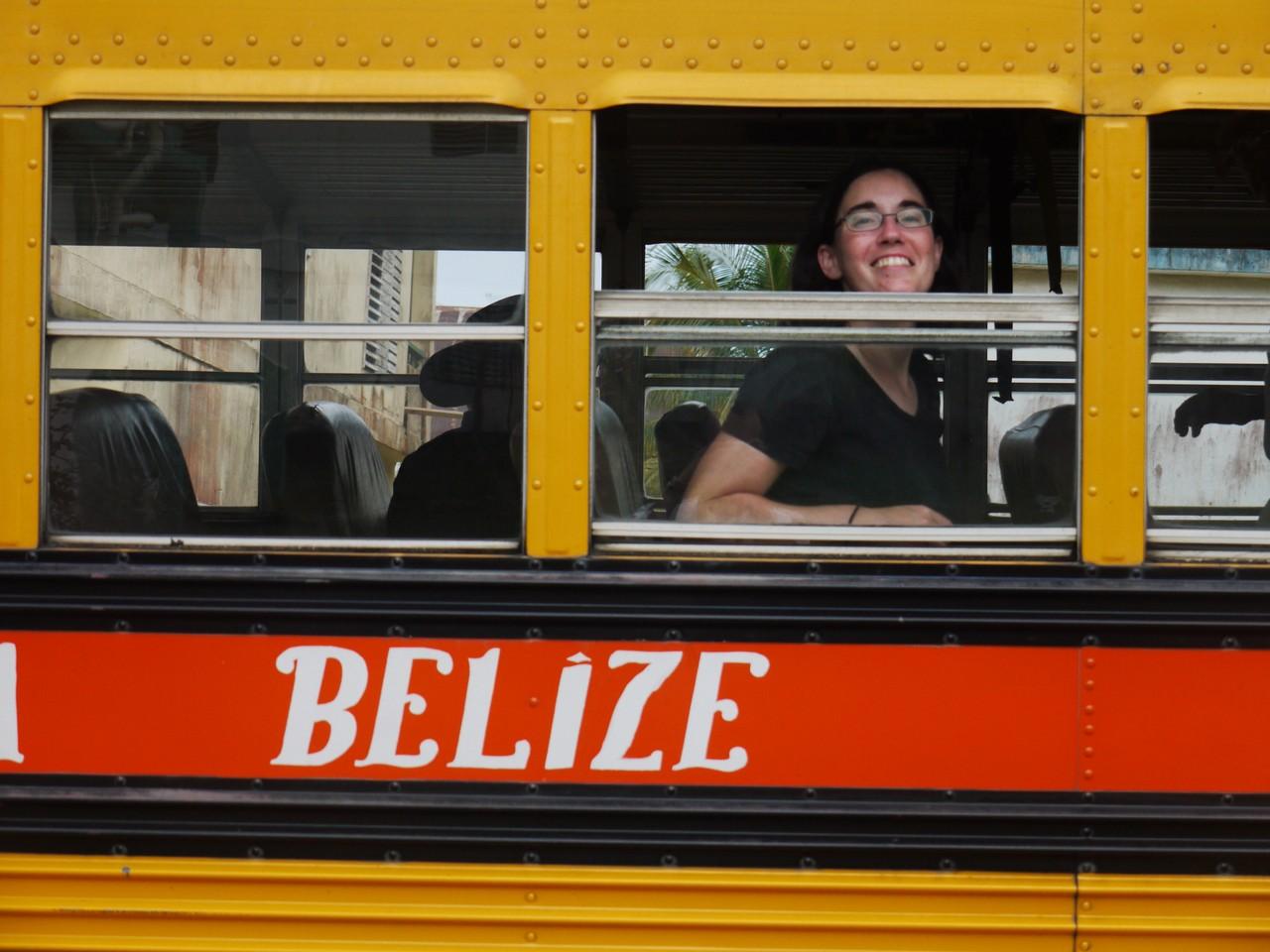 Belizean chicken bus, Punta Gorda
Belizean chicken bus, Punta Gorda
Placencia
What is it: small resort town which happens to also be a functioning community. Pastel-coloured houses, coconuts, good bars, and miles of deserted beach.
Things to do: relax on the beach, go snorkeling or sailing.
Colourful characters: Omar, who makes great seafood in his restaurant but every once in a while gravely insults a client. Ten years ago he had a run-in with a new Placencia resident, and to this day the two are not on speaking terms.
Watch out for: the Lonely Planet guide, which for some reason chose to heap scorn on Placencia, describing it as “an upper crust New England village transported to the Caribbean”, “where tourists come to [...] drive around in golf carts holding bottles of beer at 10 in the morning”. In contrast, they had only good things to say about Caye Caulker, even though the latter is more touristy, the residents aren’t as friendly, and virtually everyone drives around in golf carts.
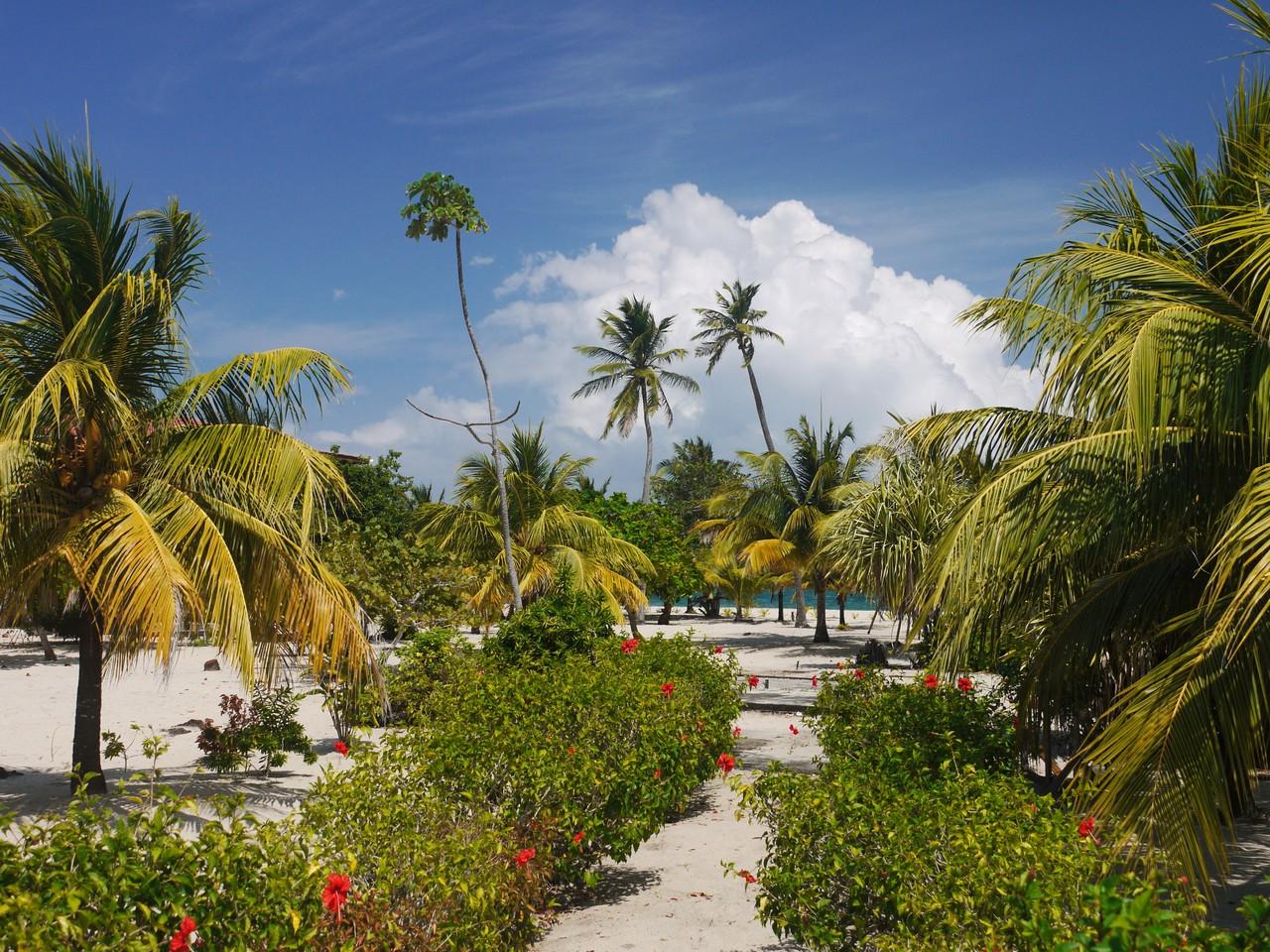 Placencia seaside
Placencia seaside
Dangriga
What is it: Garifuna town, one of the larger settlements in Belize at 10,000 inhabitants.
Things to do: very little, as far as we could tell.
Colourful characters: tend to hang out at the drum-making workshop close to the beach, at a spot known as Why-Not Island.
Watch out for: bittaz (see below).
 Caribbean architecture, Dangriga
Caribbean architecture, Dangriga
San Ignacio
What is it: prosperous little town near the western border with Guatemala.
Things to do: visit Maya ruins, go on a cave tour.
Colourful characters: John from J&R’s guesthouse, seemingly the only Belizean to be really excited about Belize.
Watch out for: five-way intersection in the centre of town swarming with overeager taxi drivers.
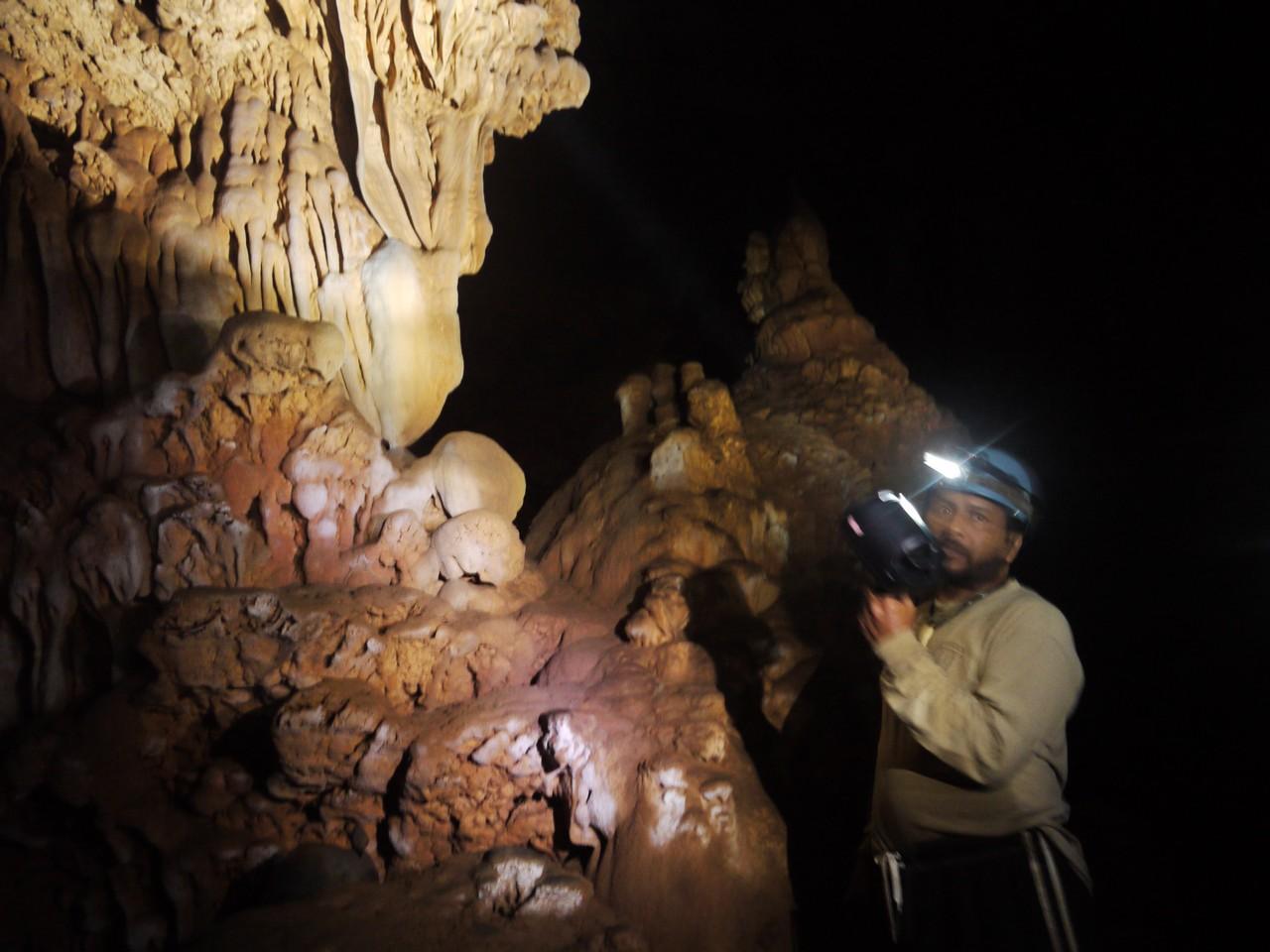 Rock formations and Maya artifacts, ATM cave
Rock formations and Maya artifacts, ATM cave
Orange Walk
What is it: “Sugar City”, farming service town in the north.
Things to do: see the ruins at Lamanai, visit what is probably Belize’s only bubble tea shop.
Colourful characters: Carlos - born in a cemetery in Algeria, ex-Foreign Legion, ex-lawyer, ex-Quebecois, currently serving up humongous pizzas and chatting up every client who comes to his restaurant.
Watch out for: the panaderia, while quite good, is not above selling yesterday’s baking to hungry backpackers.
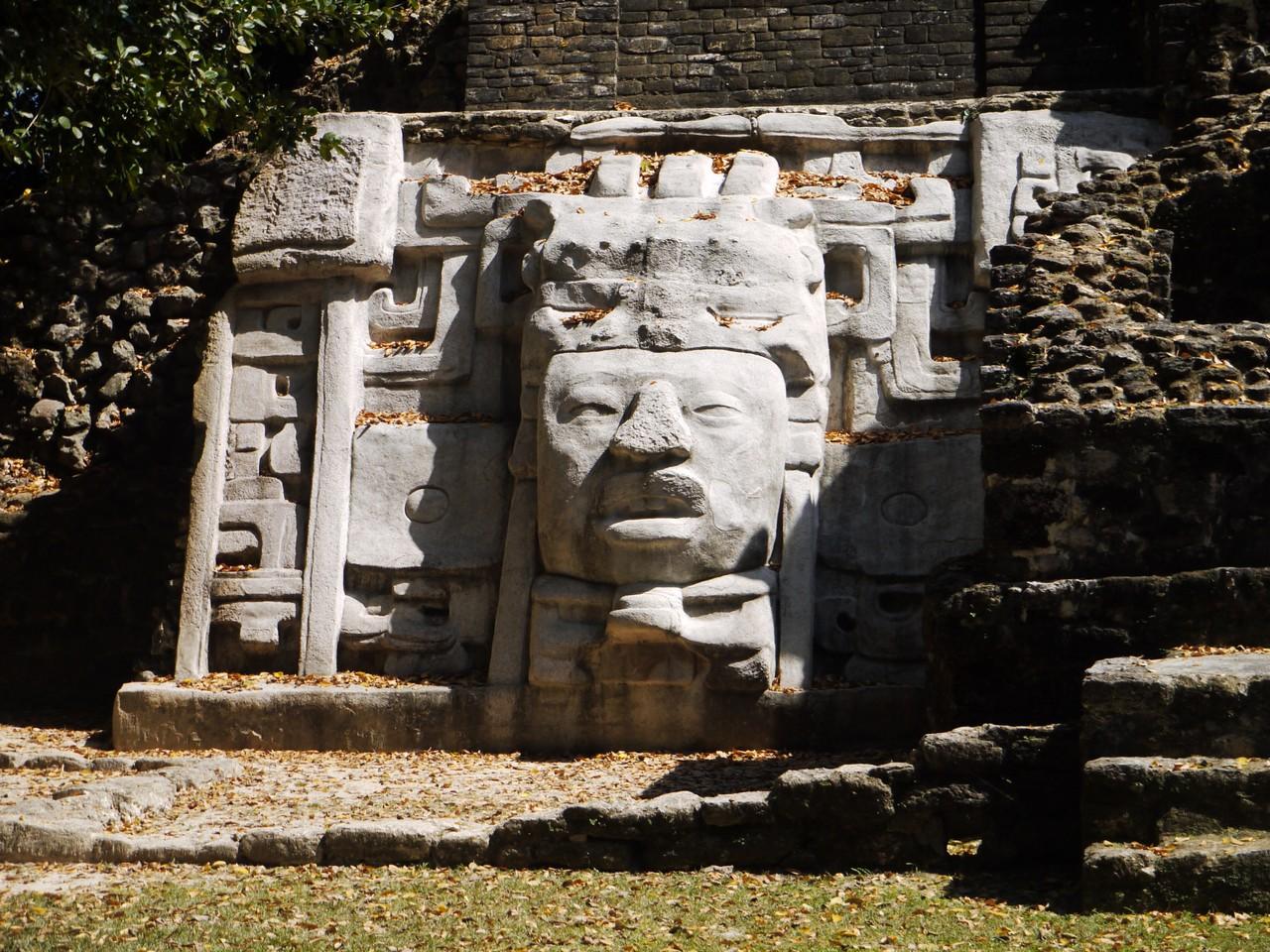 Ruins of Lamanai
Ruins of Lamanai
Blue Creek
What is it: Mennonite farming community near the Mexican border.
Things to do: if staying at the Hillside (the only organized accommodation in town): play pool with the owners, sample their blackberry wine, swing in the mechanical hammock.
Colourful characters: everyone there is Mennonite, isn’t that colourful?
Watch out for: Sunday. Absolutely nothing happens on Sunday (except church), nowhere to buy food, no way in or out unless you have a car.
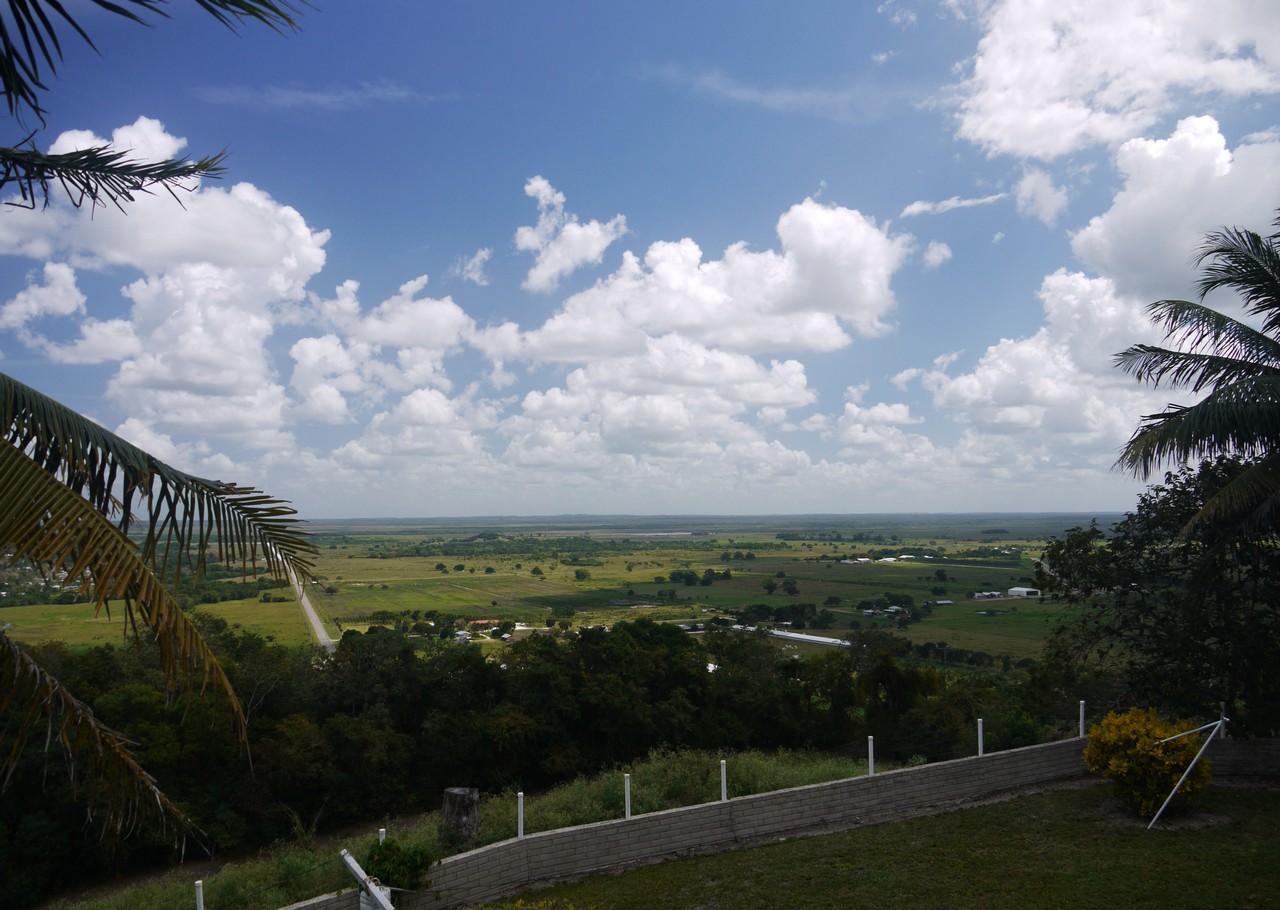 Rural Belize, view from Blue Creek
Rural Belize, view from Blue Creek
Caye Caulker
What is it: small touristy island an hour out from Belize City. The country’s only backpacker hangout.
Things to do: go snorkeling, watch an outdoor movie, watch hockey games in the sports bar, rent a bicycle and ride to the far end of the island (about 10 minutes).
Colourful characters: the “go slow” police - they’ll call you out if they catch you attempting so much as a brisk walk.
Watch out for: some locals who are by now thoroughly jaded and a little mean.
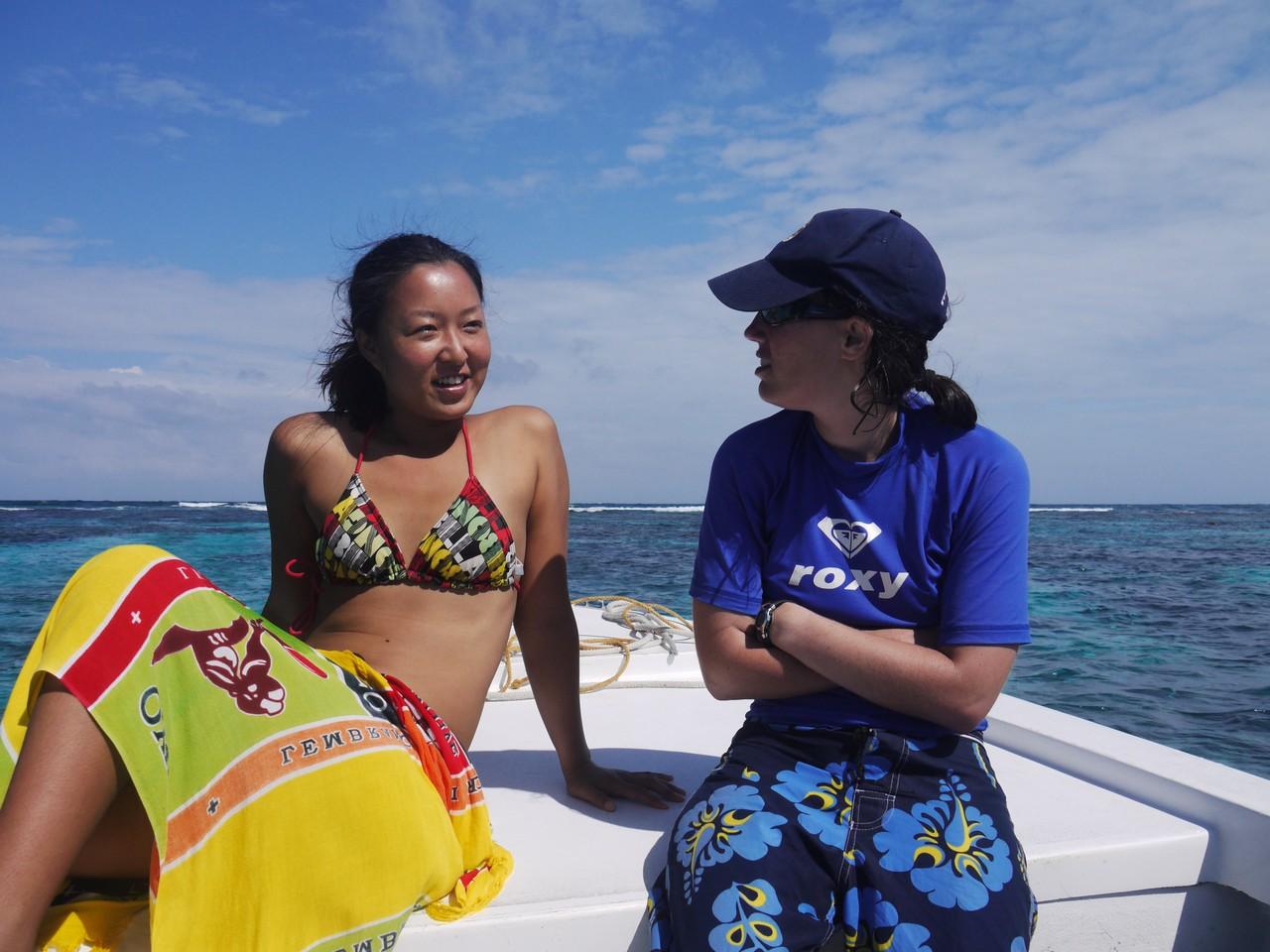 Snorkel trip off Caye Caulker
Snorkel trip off Caye Caulker
Fertility Food
Perhaps because there are so few Belizeans, they seem to be preoccupied with creating more. Conch meat is known here as “baby food”, since supposedly it helps produce babies. Then there’s a vile Garifuna concoction known as bittaz (bitters?), which “cleans out your system” and is recommended for women who are trying to conceive. It tastes like cheap liquor and doesn’t even give you an alcohol buzz.
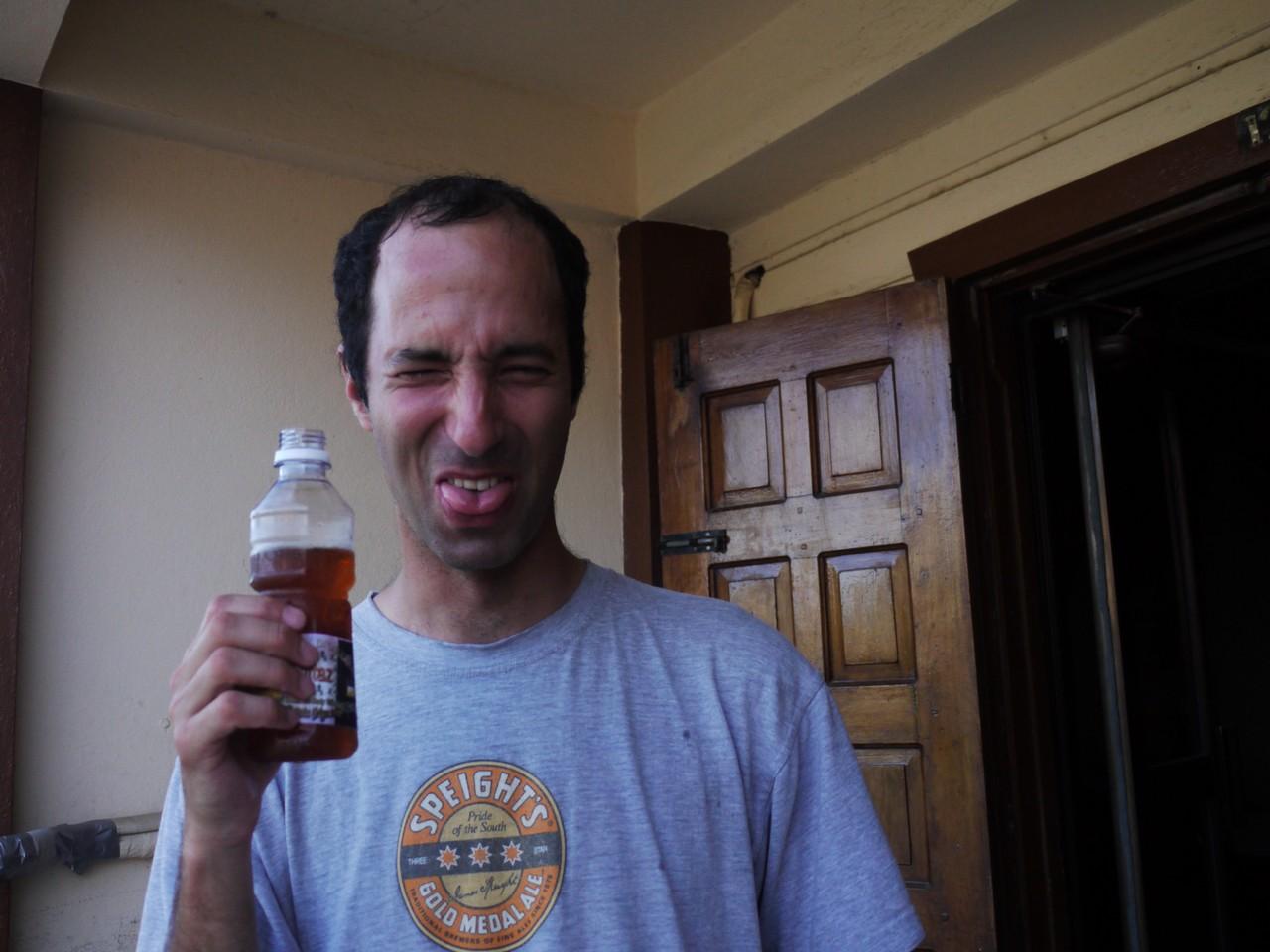 Sampling bittaz in Dangriga. Ugh!
Sampling bittaz in Dangriga. Ugh!
The Mennonites are certainly doing their part for population growth. Our host John in Blue Creek had ten children and 38 grandchildren at last count. One of the grandkids visited briefly while we were staying over:
J: “Meet K. She’s the eldest of my grandchildren”
K: “No, I’m not.”
J: “Oh right, there are two older ones...”
K: “Four.”
The Chocolate Factory
One of our first stops in Belize was a chocolate factory in Punta Gorda. “Factory” is a big word for an operation that could have easily fit in a suburban kitchen. The cacao beans are sourced from a single farmer, and a batch of around 500 chocolate bars is produced every three days. Here is the process in pictures:
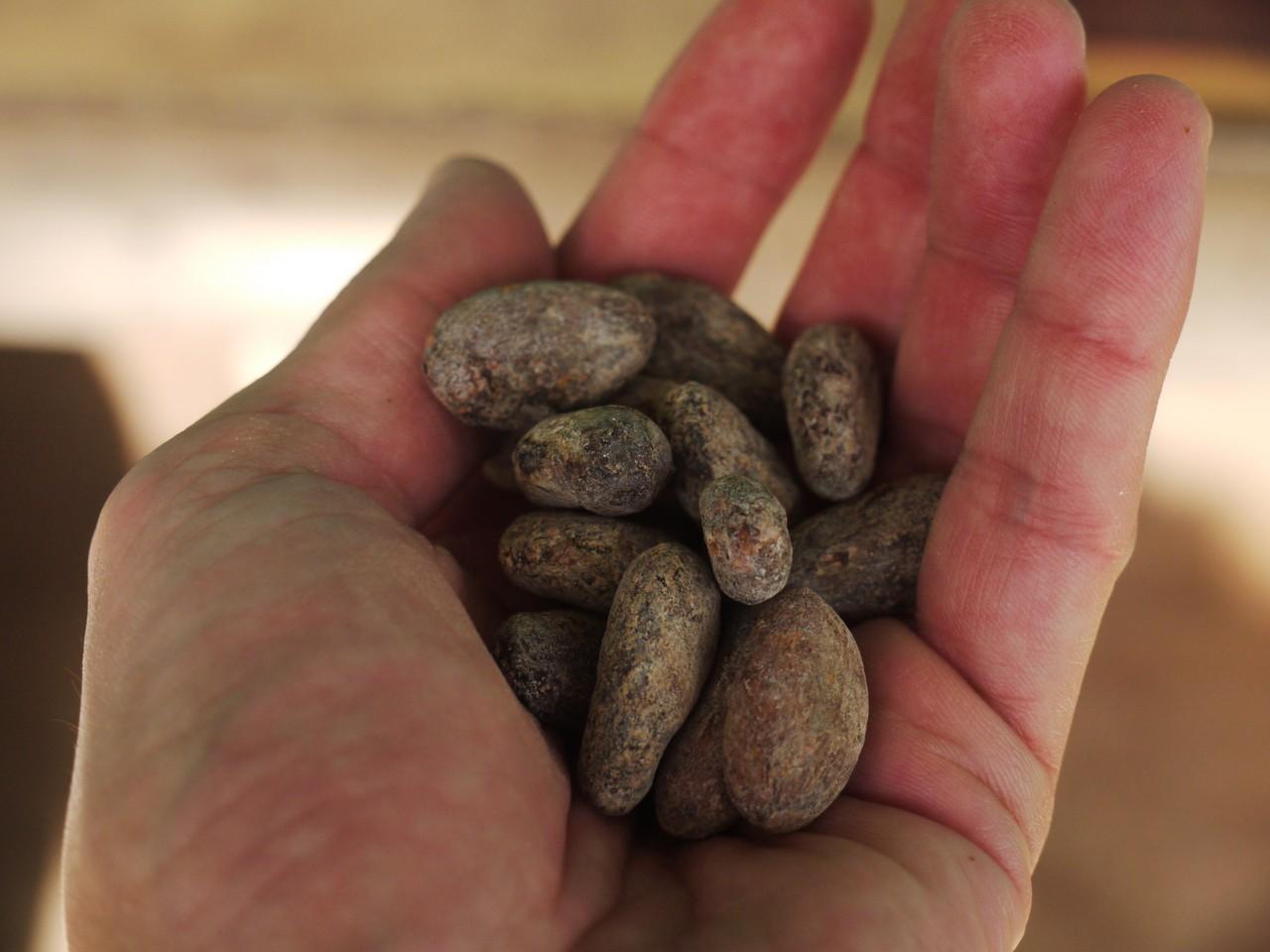 Cacao beans after drying and fermentation
Cacao beans after drying and fermentation
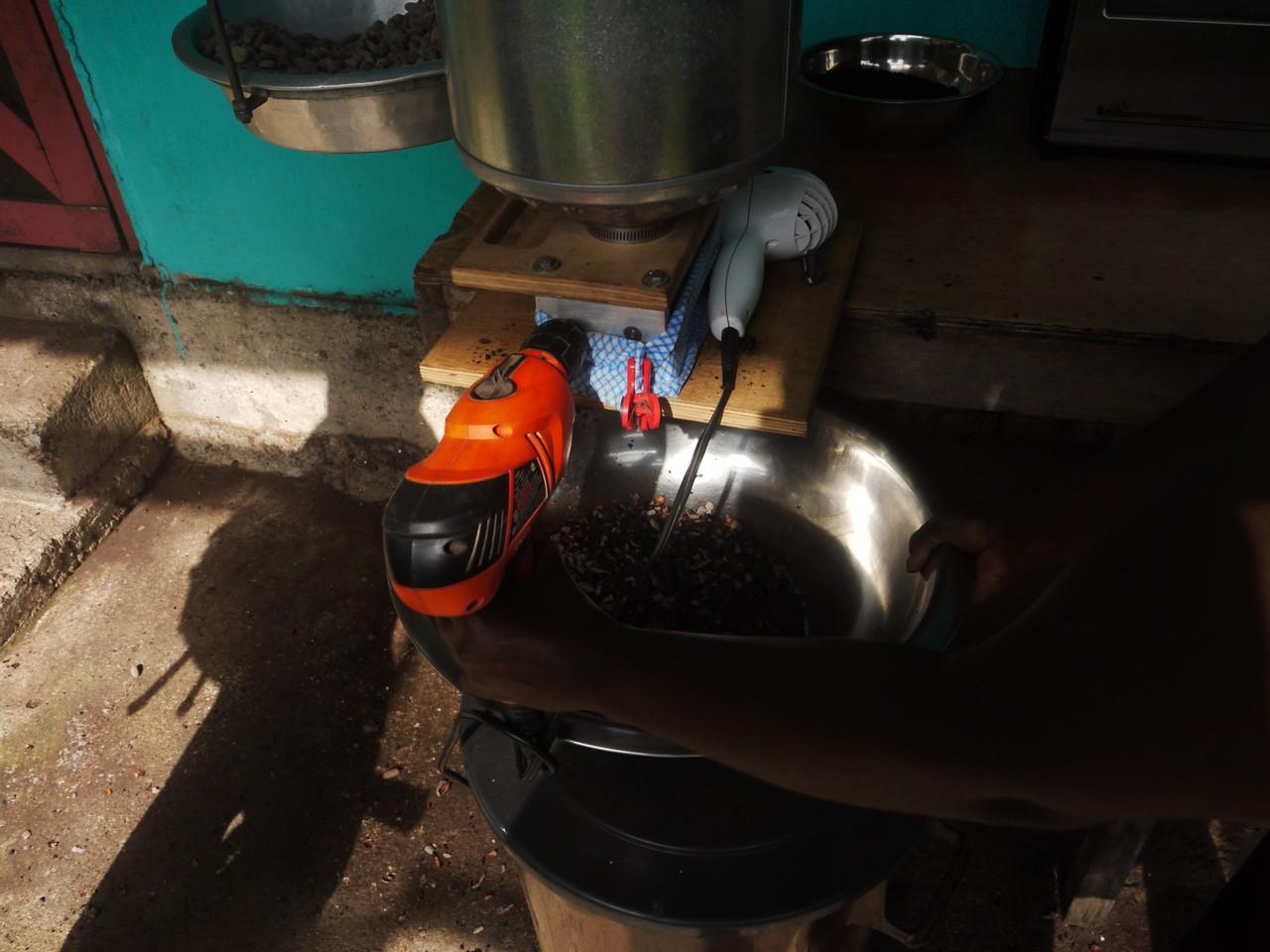 Beans are ground in a medium-sized pot. The grinder blade is hooked up to an electric drill.
Beans are ground in a medium-sized pot. The grinder blade is hooked up to an electric drill.
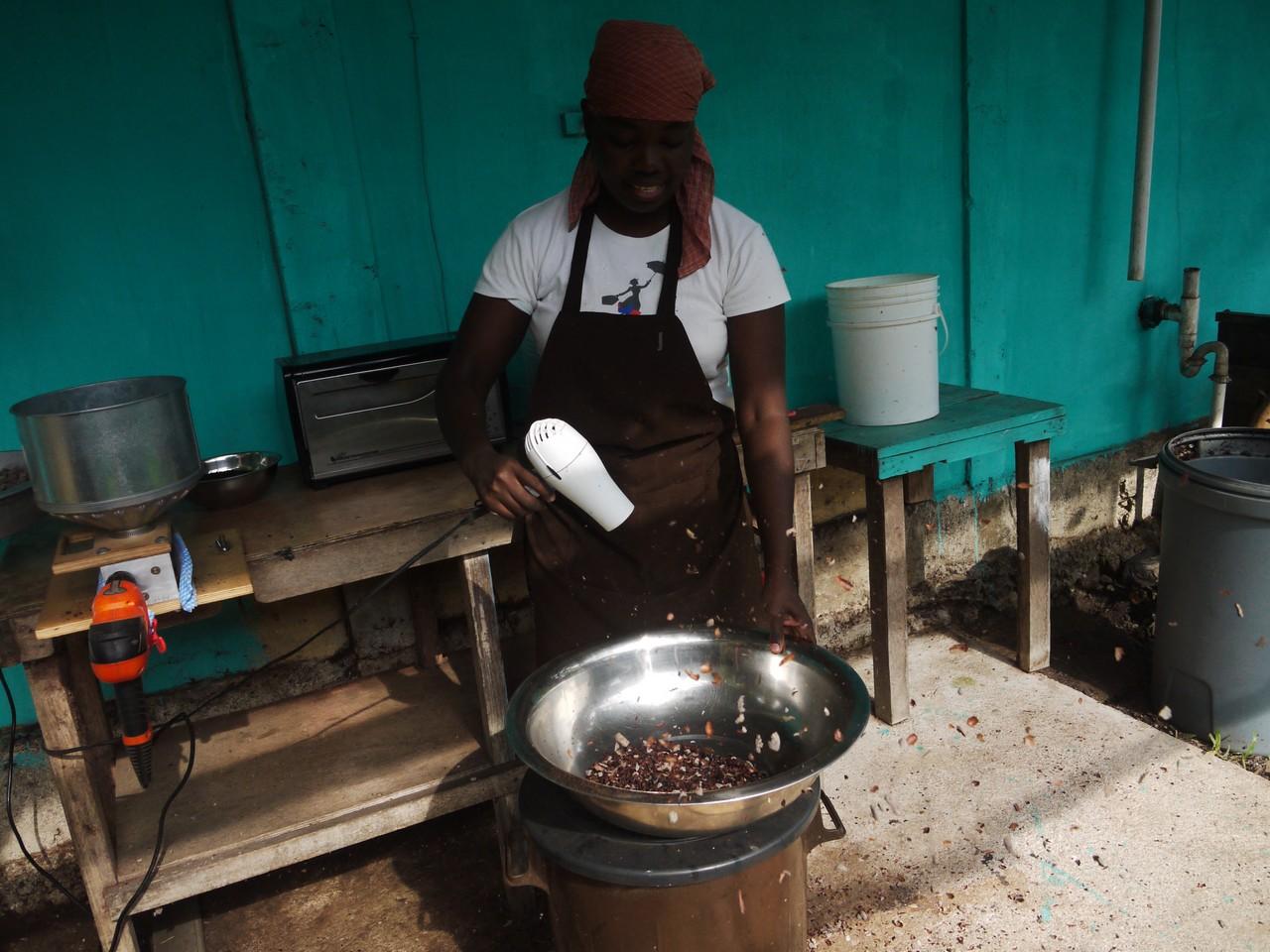 After grinding, the thin peels around the beans are disposed of via blow dryer.
After grinding, the thin peels around the beans are disposed of via blow dryer.
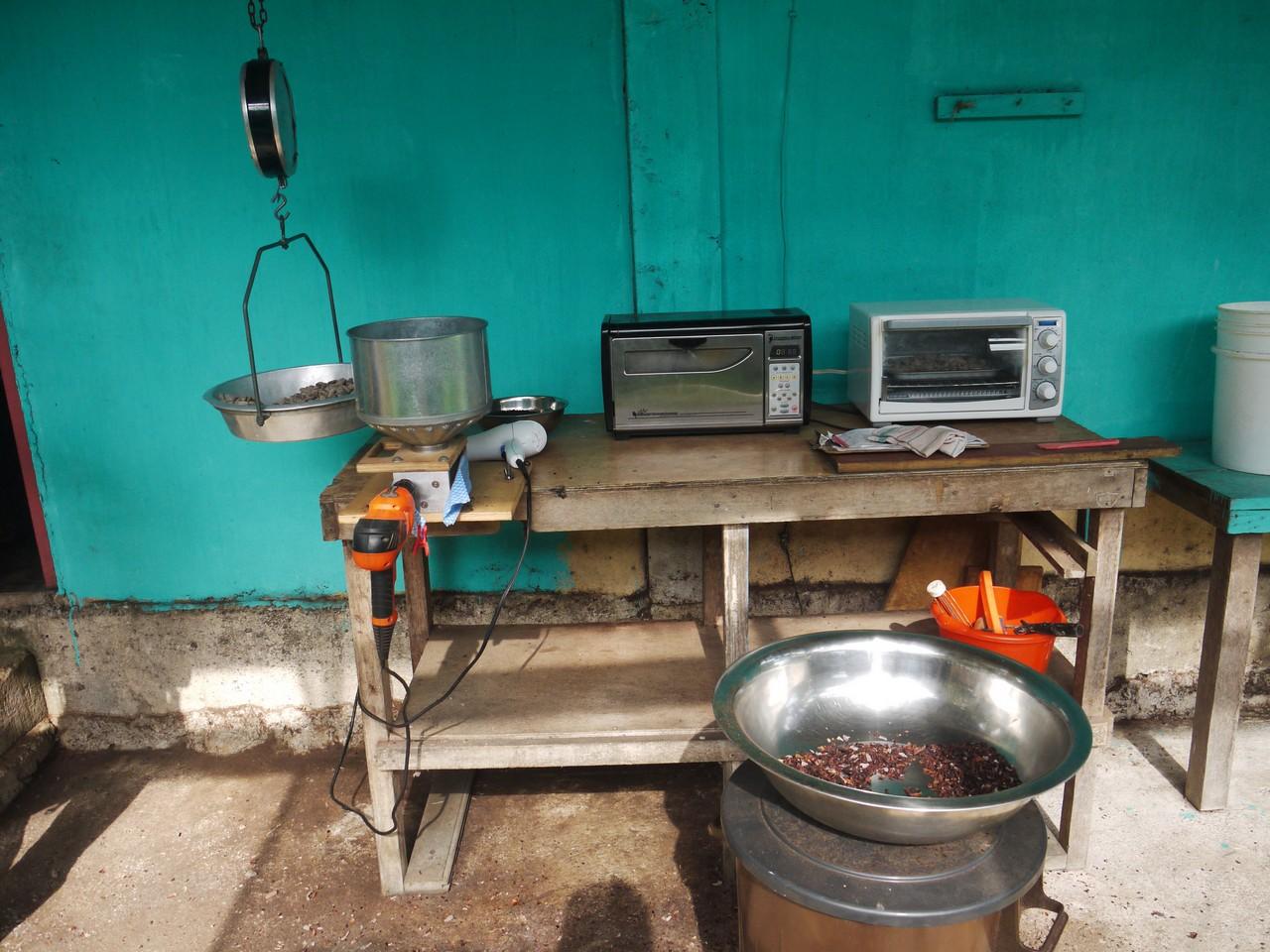 Beans are roasted in a household toaster oven. They used to have a specialized oven, but it broke down, and the toaster serves just fine.
Beans are roasted in a household toaster oven. They used to have a specialized oven, but it broke down, and the toaster serves just fine.
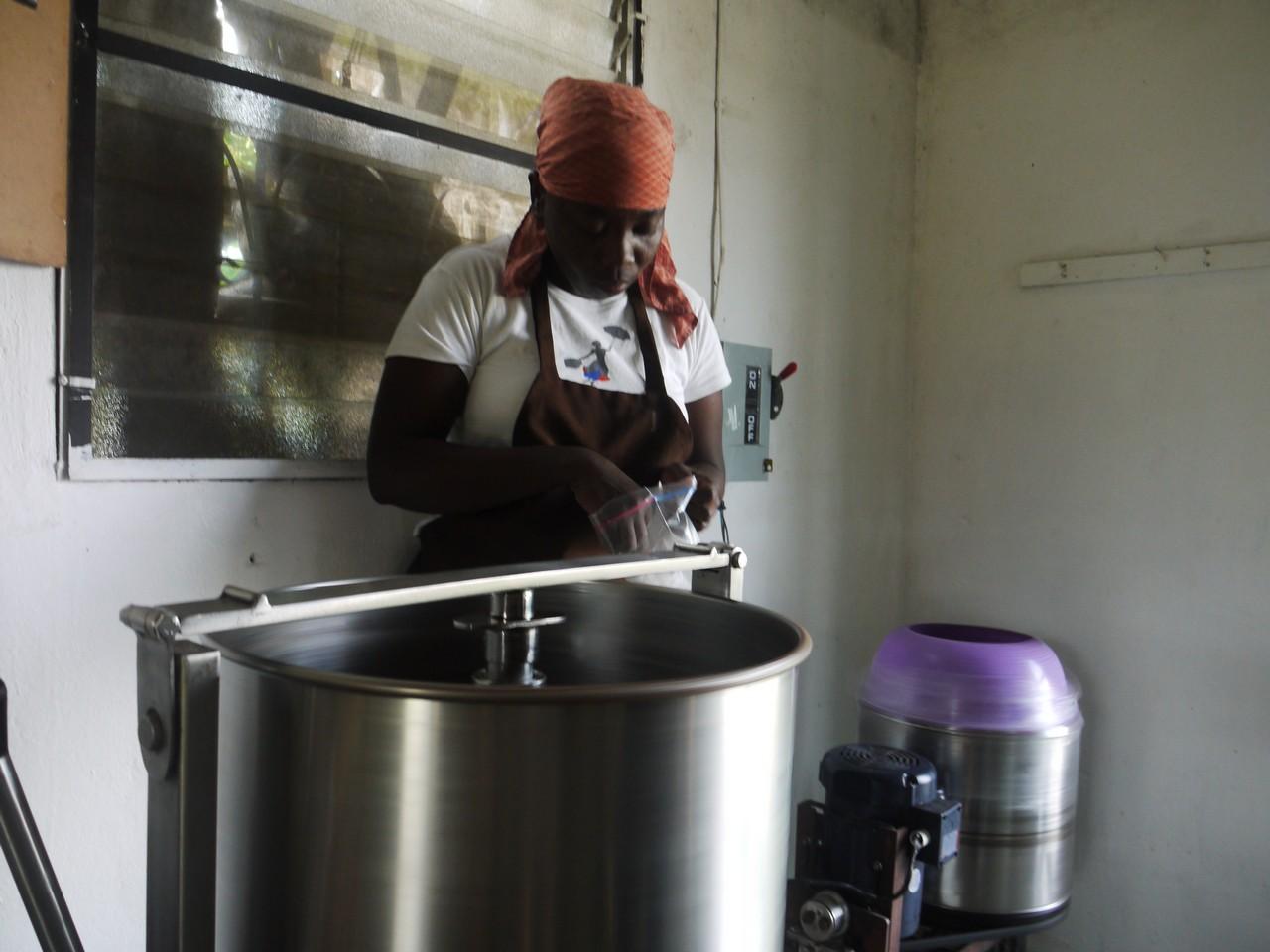 The industrial blender is the one piece of equipment that looks like it belongs in a “factory”.
The industrial blender is the one piece of equipment that looks like it belongs in a “factory”.
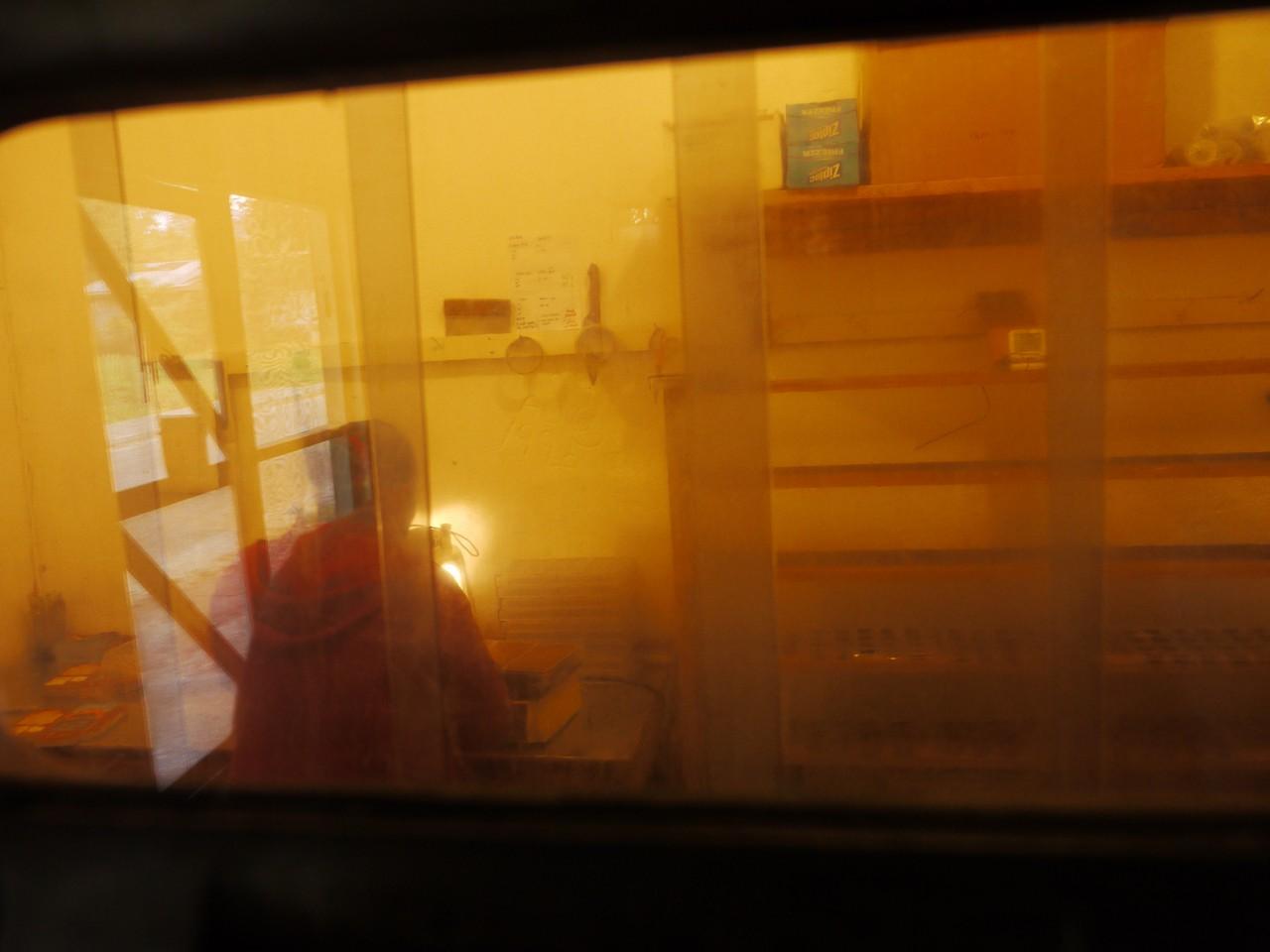 Chocolate bars are formed in an air-conditioned chamber which is kept “very cold” by Belizean standards - about 18˚C.
Chocolate bars are formed in an air-conditioned chamber which is kept “very cold” by Belizean standards - about 18˚C.
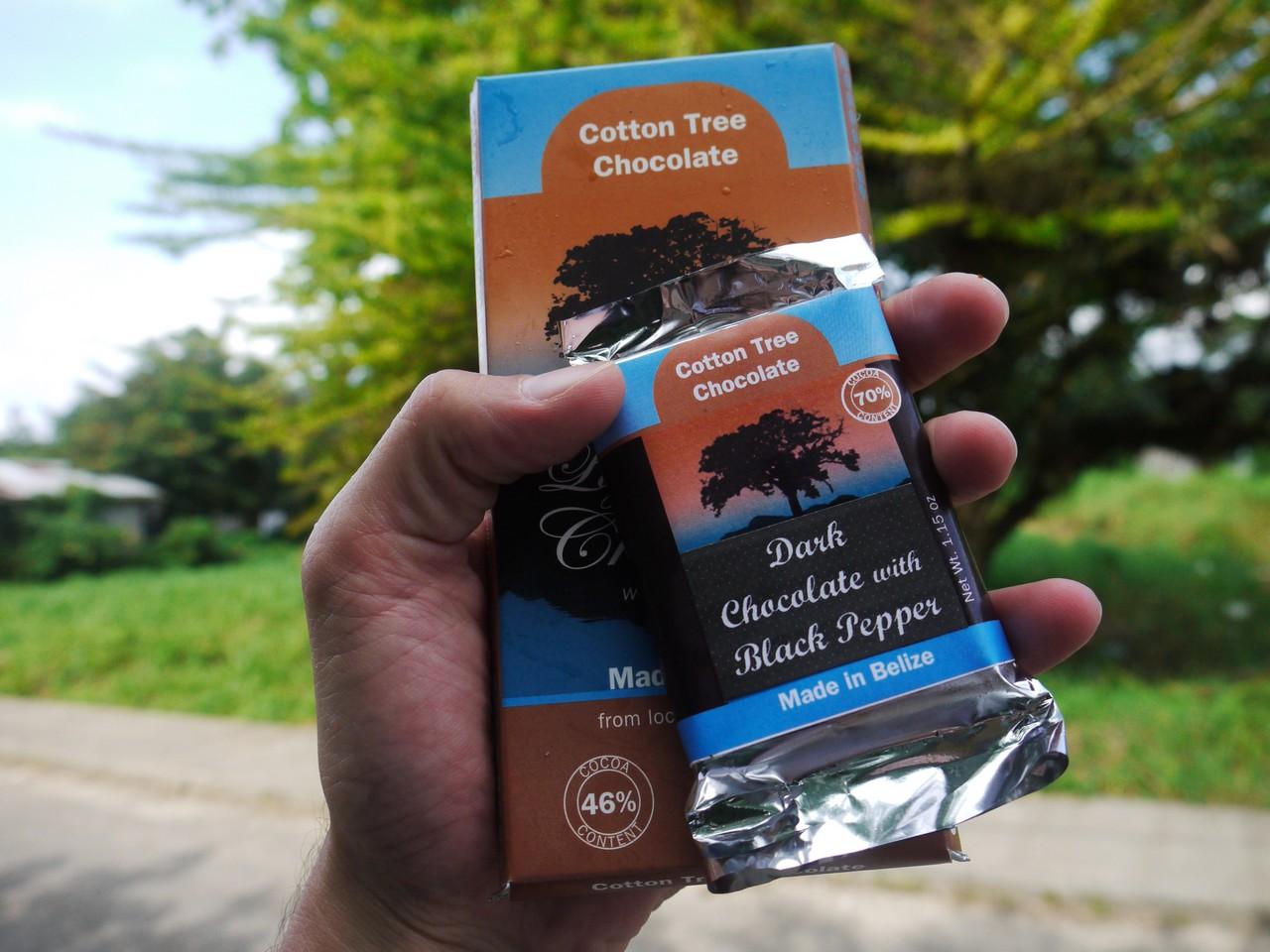 Fresh chocolate. Tastes amazing!
Fresh chocolate. Tastes amazing!
Show Me the Malaria!
Is there malaria in Central America? Glad you asked! But the answer varies depending on who you ask. Aside from occasional dengue outbreaks, none of the tropical diseases is an outright epidemic around here, and some travellers simply don’t worry about it - they receive no vaccinations, take no precautions against insect bites, and for the most part they return home healthy and happy.
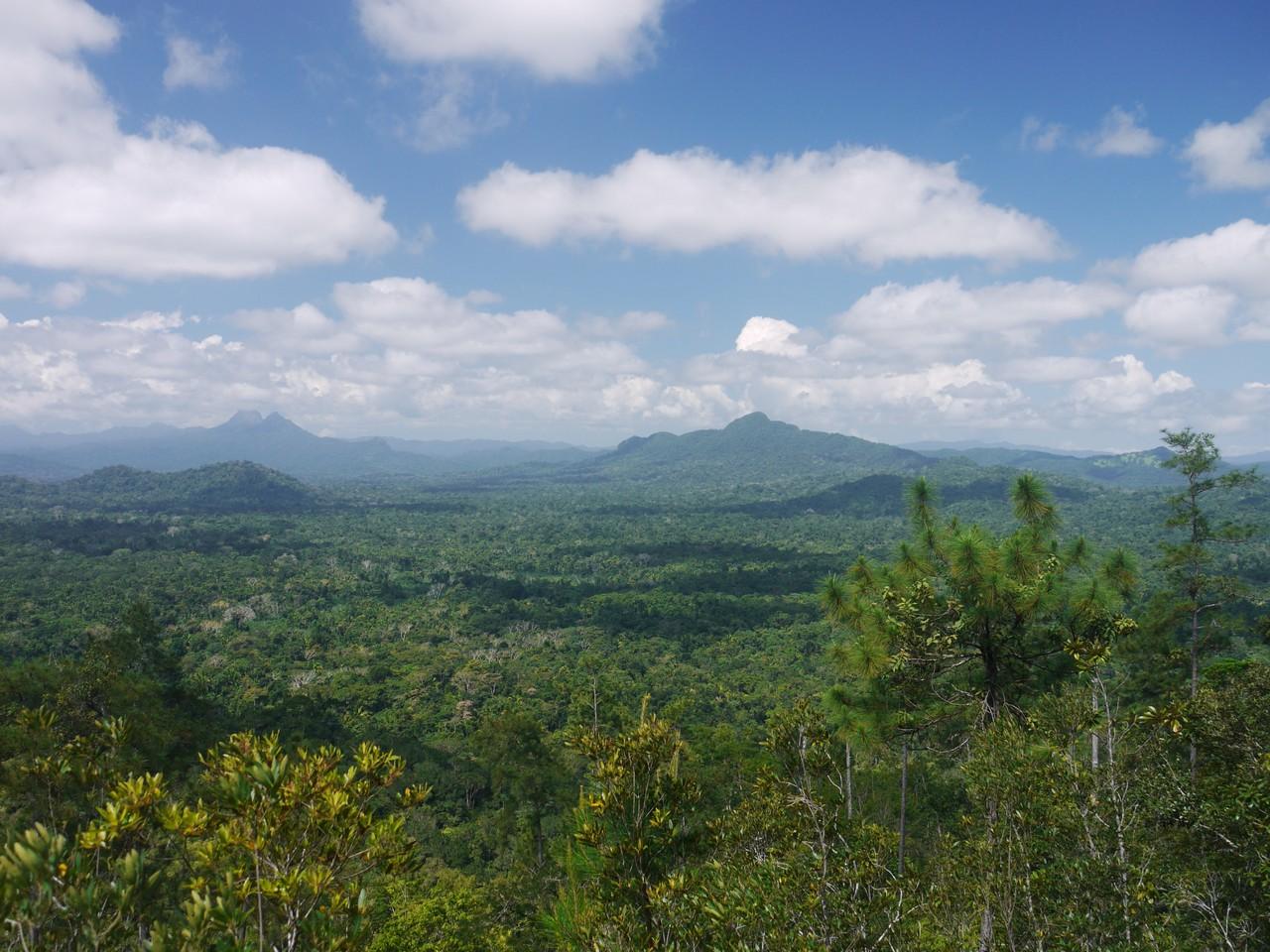 Cockscomb Wildlife Sanctuary, view from Ben's Bluff
Cockscomb Wildlife Sanctuary, view from Ben's Bluff
Others (such as us) have a lower tolerance for risk. Before leaving on this trip we stopped by the travel clinic in Vancouver for a complete briefing and vaccine checkup. The doctor, a travel professional who clearly knows her Nicaraguas from her Costa Ricas, pulled out a set of detailed country maps showing areas with malaria risk. She cross-checked them against our itinerary and determined how long we’ll be travelling in the “malaria zone”. She then prescribed chloroquine tablets - a cheap, effective pill with no side effects apart from a horrendous aftertaste that makes you want to vomit.
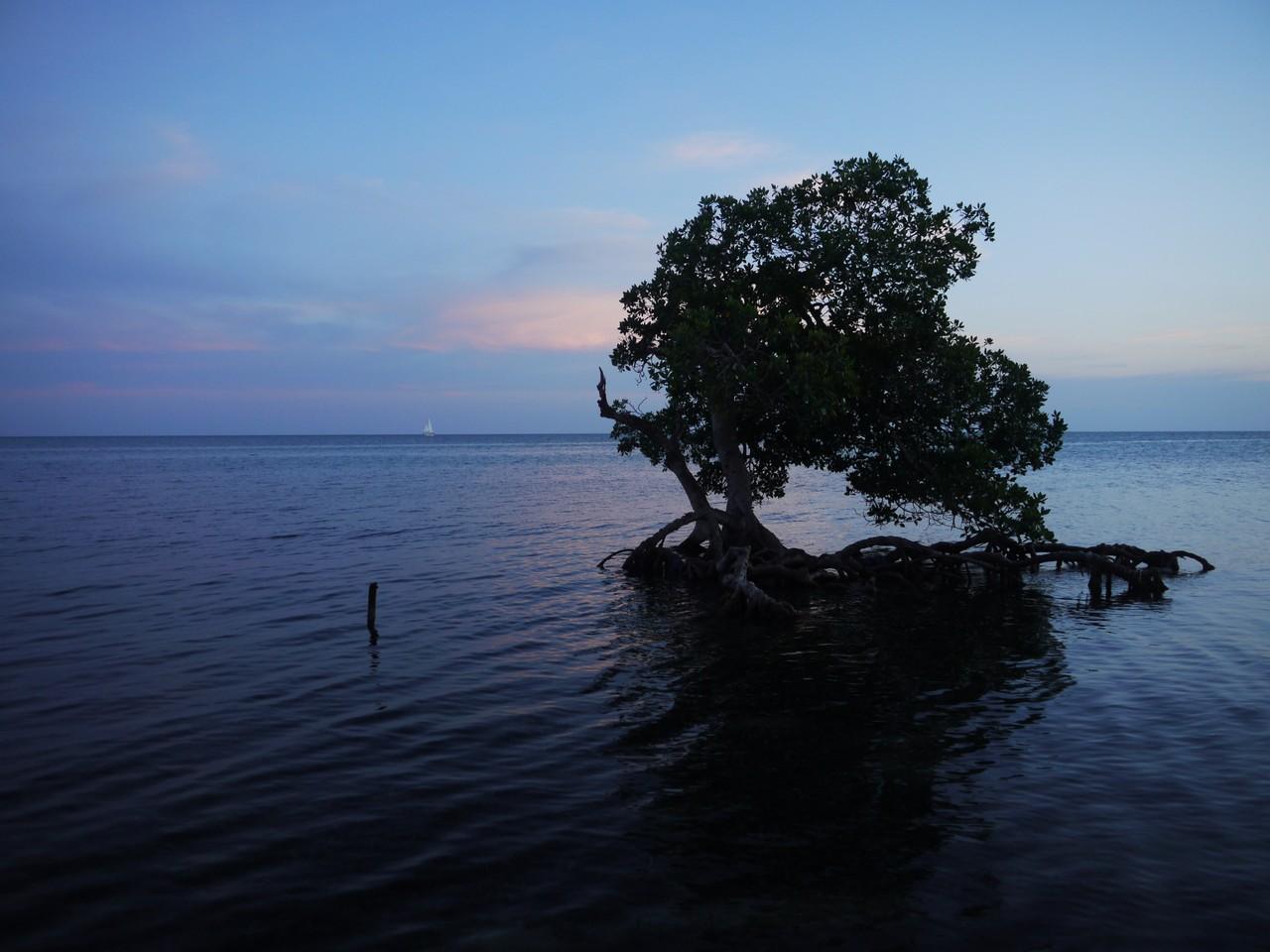 Solitary mangrove, Placencia
Solitary mangrove, Placencia
We did some digging online and discovered that the doctor’s maps are issued by Britain’s National Health Service. The American Center for Disease Control publishes its own set of maps, and guess what - they’re not the same at all!
What’s a responsible traveller to do? We decided to stick to the good doctor’s instructions. Out of curiosity, we asked some other travellers what advice they had received. An Israeli couple on a similar Central America traverse consulted two different experts back home, and the experts were in agreement: there is no malaria risk in the region, no protection is required. A German volunteer on a three-month stint in the jungles of southern Belize (a “high-risk” area according to NHS and CDC) had received similar advice from her doctor: no malaria risk, end of story.
Is there a lesson here? Perhaps only that risk assessment is hard.
The Flag
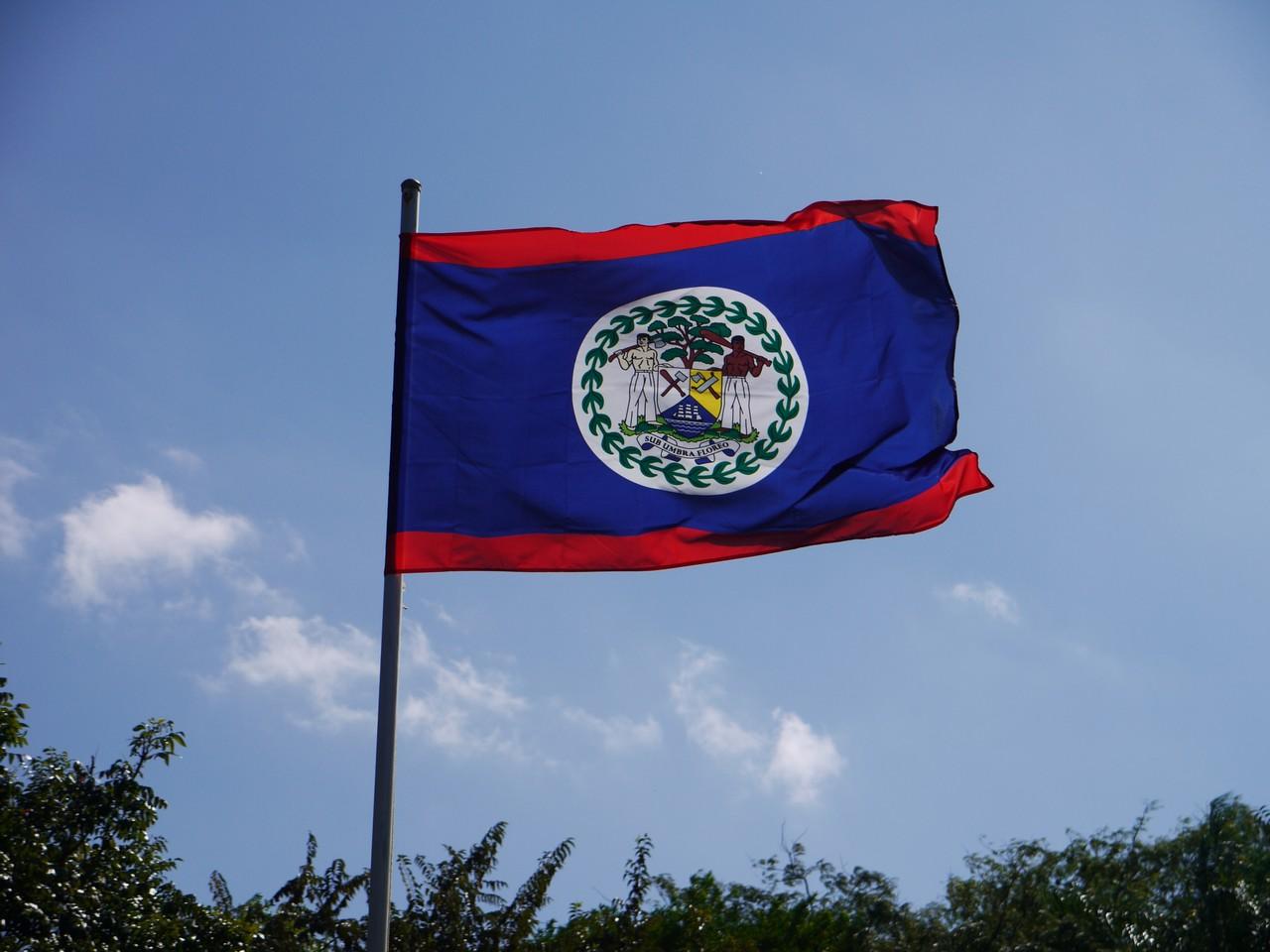 Belizean flag
Belizean flag
Explanation of the Belizean flag, provided by a rather drunk local in San Ignacio:
The blue represents the party that was in power when Belize gained independence. The red stripes represent the opposition. The tree is mahogany, staple of the timber industry that got the colony started. The two men are woodcutters: the mestizo with his axe, the black man with his oar. The Latin motto translates as “in the shade we flourish”, which some Belizeans take to mean they should lie down and avoid doing any work.
Bonus album: Signs of Belize